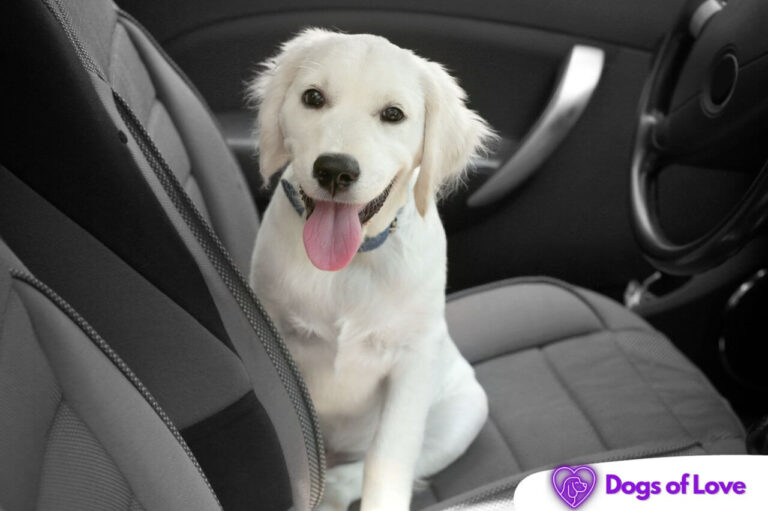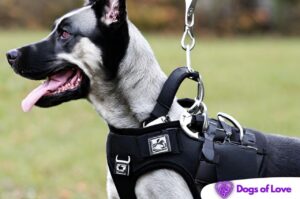Introducing the effectiveness of a dog seatbelt raises essential questions regarding the safety and security of our beloved canine companions during car travel.
Like human seatbelts, dog seatbelts are designed to provide protection and restraint, aiming to mitigate potential dog injuries in a car accident or sudden stops.
However, assessing their actual effectiveness involves understanding the design, functionality, and real-world performance of these safety devices.
In this exploration, we delve into the features of dog seatbelts, how they work, and their ability to keep our furry friends safe and secure while traveling in vehicles.

What is a dog seatbelt, and why is it essential to have one?
A dog seatbelt is a safety device designed to secure a dog in a car during travel, much like a seatbelt for humans.
It typically consists of a harness attached to a car’s seatbelt system or directly to the seat, effectively restraining the dog’s movement and keeping them in a specific vehicle area.
The importance of having a dog seatbelt lies in enhancing safety for both the dog and the passengers.
In the event of an accident or sudden stop, an unrestrained dog can become a projectile, potentially causing injury to themselves and others.
A dog seatbelt helps mitigate these risks by keeping the dog secured and reducing the likelihood of being thrown inside the vehicle.
It promotes responsible pet ownership, ensuring that dogs are not a distraction to the driver and are safe throughout the journey.
What are the risks of using a dog seat belt?
The risks associated with using a dog seatbelt primarily revolve around uncertainty regarding their effectiveness.
A notable concern is the limited number of dog seatbelts that have undergone rigorous crash testing to validate their safety claims.
The lack of standardized testing protocols for these products makes it challenging to assess their true protective capabilities during a car accident.
Consequently, some dog seat belts may not provide the anticipated level of protection, potentially resulting in injuries to the dog or even being ineffective in restraining them.
This ambiguity underscores the need for comprehensive research, industry standards, and clear guidelines to ensure the reliability and efficiency of dog seatbelts in enhancing canine safety during car travel.
How to tell if your dog’s seat belt is safe and effective?
To determine if your dog’s seat belt is safe and effective, several crucial factors need to be considered.
First and foremost, ensure that the seat belt is appropriately sized and fits your dog snugly without causing discomfort or restricting movement.
Look for seat belts that have been crash-tested and certified by reputable organizations or independent testing facilities.
A reliable dog seat belt typically has clear labeling indicating its crash test results and safety certifications.
Check for solid and durable materials, sturdy buckles, and reinforced stitching to ensure it can withstand the forces experienced during a collision.
Opt for a seat belt that securely attaches to the car’s seatbelt system and has a solid harness to distribute the force of impact evenly across your dog’s body.
Regularly inspect the seat belt for any signs of wear and tear, and replace it if it shows any damage or weakening.
Always follow the manufacturer’s instructions on proper usage and installation to maximize safety for your canine companion.
What are the Alternatives to the traditional dog seatbelt?
There are several alternatives to the traditional dog seatbelt that can provide safety and comfort for your canine companion during car travel.
One standard option is a pet travel crate or carrier, which confines your dog to a secure and designated space within the vehicle, reducing their ability to move around.
Another alternative is a dog-specific car harness that connects to the car’s seatbelt system, offering restraint while allowing some freedom of movement.
Additionally, pet car seats or booster seats elevate smaller dogs to give them a better view and added security.
Barrier nets or gates can create a barrier between the dog and the rest of the car, preventing them from distracting the driver.
Choosing these alternatives depends on your dog’s size, temperament, and preferences. Still, the primary goal is to ensure their safety while minimizing distractions and discomfort during car rides.
How to properly install and use a dog seatbelt?
Properly installing and using a dog seatbelt ensures your pet’s safety during car travel. To begin, select a seatbelt suitable for your dog’s size and weight.
Follow the manufacturer’s instructions closely for installation.
Typically, you’ll need to attach the seatbelt clip to your dog’s harness, not their collar, to distribute force evenly across their body.
Place your dog in the designated area of the car, securing the seatbelt attachment to the car’s seatbelt receptacle.
Ensure the seatbelt is adjusted to allow your dog to sit or lie down comfortably but not to move around excessively.
Regularly check for wear and tear on the seatbelt and harness, replacing them if damaged.
It’s crucial to educate yourself on the specific usage guidelines provided by the manufacturer to effectively restrain your dog and ensure their safety throughout the journey.
Always encourage your dog to become accustomed to the seatbelt gradually and never force them into it.
By following these guidelines, you can enhance the safety of your dog and other passengers while minimizing distractions during car rides.
In conclusion
The effectiveness of a dog seatbelt in ensuring the safety and well-being of our canine companions during car travel depends on various factors.
While restraining a dog in a moving vehicle is sound, the actual effectiveness of a dog seatbelt lies in its design, testing, and proper usage.
Unfortunately, many dog seatbelts on the market lack standardized testing and certification, making it challenging to ascertain their protective capabilities during an accident.
Crash-tested and certified dog seatbelts offer a higher confidence, but their availability and adoption are limited.
Thus, carefully considering the seatbelt’s fit, quality, adherence to safety standards, and proper installation is crucial to ensuring that it effectively restrains and protects dogs, reducing potential injuries and enhancing their safety during car rides.
Continued research, industry standards, and greater awareness among pet owners are essential to improve the overall effectiveness of dog seatbelts and enhance canine safety on the road.








